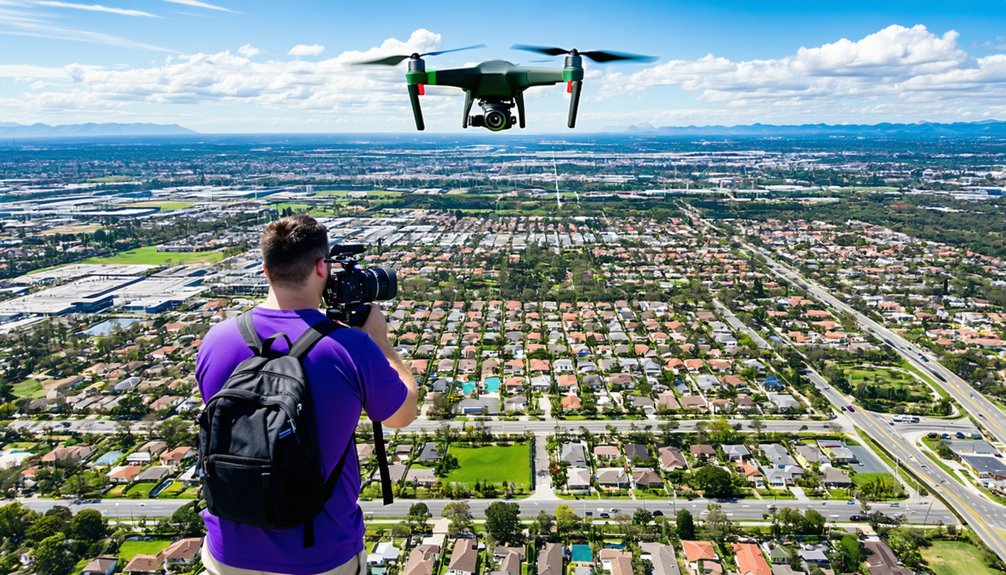As a drone photography and videography agent, you face a complex environment of legal requirements and best practices. Understanding FAA regulations, including the need for a Part 107 license, is significant to guarantee your operations are compliant and safe. You’ll also need to navigate issues around copyright and privacy, which can impact your projects considerably. Knowing these intricacies could be the difference between a successful shoot and costly legal complications. What steps will you take to safeguard your work?
FAA Certification and Operational Restrictions
When you decide to venture into drone photography and videography, understanding FAA certification and operational restrictions is key for your success and safety.
To legally operate commercially, you need a Part 107 license, which requires you to pass the Unmanned Aircraft General knowledge test. Before taking the test, confirm you’ve obtained your FAA Tracking Number and complete FAA Form 8710-13. Additionally, ensure you meet the minimum age requirement of 16 years old before applying for the certification. Becoming a successful agent requires completion of courses to build your foundational skills.
Remember that operational waivers are necessary for night flights, flying over people, or from moving vehicles. Always maintain visual line of sight unless you’ve secured a waiver.
Additionally, keep in mind that your drone must be registered and display its identification number, guaranteeing compliance with FAA regulations. Staying informed about these requirements is important for your drone operations.
Copyright and Privacy Considerations
Navigating the world of drone photography and videography involves not just technical skills and FAA compliance, but also understanding the legal framework of copyright and privacy.
You typically own the copyright to the footage you capture, unless a contract states otherwise. Always clarify copyright ownership in contractual agreements to avoid disputes. Registering your work with the U.S. Copyright Office enhances your protection and legal options, particularly since aerial footage as original audiovisual work is protected by copyright. Additionally, being aware of cybersecurity risks can help you safeguard your work and client information from potential threats.
On the privacy front, be aware that flying over private property without permission can infringe on privacy rights. Respect individuals’ rights to privacy by seeking consent before capturing footage, especially in sensitive areas. Following these guidelines will help you navigate the complexities of copyright and privacy in your drone operations effectively.
Insurance, Risk Management, and Best Practices
As drone operations continue to grow in popularity, understanding insurance and risk management is important for safeguarding your investment and guaranteeing compliance with regulations. Start by evaluating potential risks like crashes or injuries, which will inform your risk assessment and planning. Opt for tailored insurance coverage that includes general liability and equipment insurance to protect against loss. Companies like The Hartford and Insureon offer specialized drone policies to consider. Additionally, consider the importance of drone photography insurance as it provides essential protection against claims that could financially devastate your business. Establishing a baseline budget for your drone operations can help manage costs and ensure adequate coverage.
Implement safety protocols during operations and provide training for your team to minimize risks. Conduct pre-flight checks, monitor weather conditions, and establish emergency plans to further enhance safety. Regularly review your insurance policies to confirm they meet your business needs and keep you protected.
Frequently Asked Questions
What Are the Penalties for Flying Drones Without FAA Certification?
Flying drones without FAA certification exposes you to significant penalties. You could face civil fines, legal consequences, and even criminal charges, highlighting the importance of compliance to avoid serious repercussions and protect public safety.
How Do I Report a Drone Incident or Accident?
To report a drone incident, you’ll need to document details and submit your findings to the FAA within 10 days. Prioritize drone safety by following incident reporting guidelines and maintaining thorough records throughout the process.
Can Drones Be Used for Live-Streaming Events?
Yes, drones can enhance live streaming events by providing significant aerial coverage. You’ll capture unique perspectives, engaging viewers, and showcasing event highlights effectively, maximizing the live streaming benefits for your audience and creating memorable experiences.
What Are the Restrictions for Flying Drones at Night?
When flying at night, you must follow night flight regulations, including using anti-collision lights. Prioritize nighttime safety precautions, guaranteeing visibility and maintaining line-of-sight to avoid collisions and ensure safe operations throughout your flight.
How Do I Ensure My Drone Is Compliant With Local Laws?
To guarantee compliance, familiarize yourself with drone registration requirements and local airspace regulations. Regularly check state and municipal laws, and utilize resources like the B4UFLY app to stay informed about any changes affecting your operations.
References
- https://www.scoredetect.com/blog/posts/copyright-protection-for-drone-photography-legal-basics
- https://www.ppa.com/education/drone-knowledge-center/faa-drone-regulations
- https://www.thimble.com/blog/drone-photography-license-guide
- https://uavcoach.com/aerial-videography/
- https://rephotojournal.com/using-drones-legally-for-real-estate-photography-and-video/
- https://www.faa.gov/uas/commercial_operators/become_a_drone_pilot
- https://www.faa.gov/uas/commercial_operators
- https://uavcoach.com/drone-certification/
- https://www.faa.gov/uas/getting_started
- https://www.thedroneu.com/blog/part-107-license-guide/

